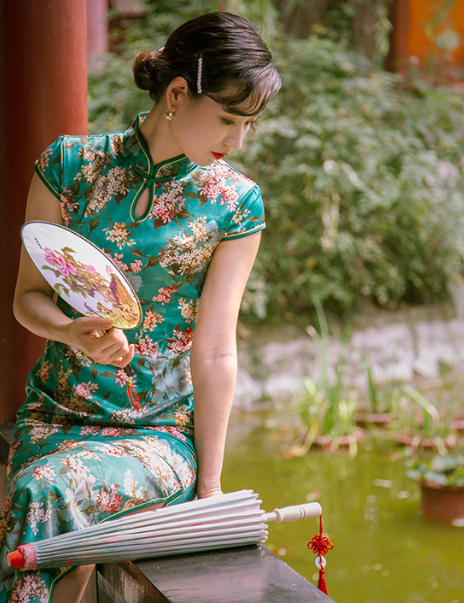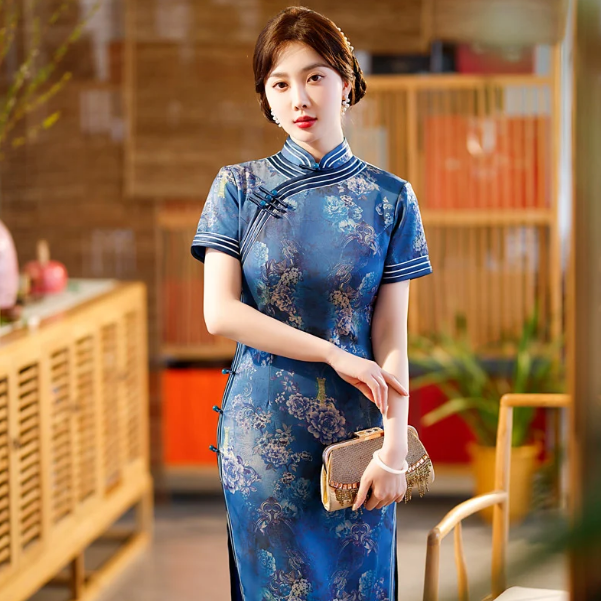Historical Origins
Ancient Beginnings and Evolution
The cheongsam, known as qipao in Mandarin, traces its roots to the ancient clothing of the Manchu ethnic group, a dominant force in the Qing Dynasty. Originally, the Manchu women wore loose, straight-cut gowns. Over time, influenced by Han Chinese clothing styles and the modernization waves in the early 20th century, the cheongsam evolved significantly. This dress started to feature a more form-fitting cut, highlighting the feminine silhouette, a stark contrast to its earlier versions. The transformation of qipao can be seen as a reflection of societal changes in China, especially in women’s social status and fashion liberation.

Influence of the Qing Dynasty·
During the Qing Dynasty (1644–1912), the Manchu rulers mandated a strict dress code, where the traditional Han clothing was largely replaced by the Manchu qipao. This period saw the cheongsam evolve from a simple daily wear garment into a more elaborate outfit, suitable for high society and royal functions. Fabrics like silk and brocade, often adorned with intricate embroideries, became prominent, signifying wealth and status. The Qing Dynasty’s influence cemented the cheongsam’s place in Chinese culture, making it a timeless symbol of elegance. The importance of the Qing Dynasty in shaping the cheongsam is evident in the exquisite craftsmanship and the attention to detail seen in the garments from that era.
In the context of these two aspects, we don’t specifically discuss aspects like power, cost, efficiency, lifespan, age, value, time, advantages, materials, quality, speed, or disadvantages in numerical details, as the focus is more on the historical and cultural evolution of the cheongsam rather than its technical specifications.
Cultural Significance
Symbolism in Chinese Culture
The cheongsam, beyond being just a fashion statement, encapsulates deep cultural meanings. It symbolizes grace, modesty, and the beauty of Chinese culture. The dress often features motifs like dragons, phoenixes, and flowers, each representing different qualities like power, femininity, and renewal. Colors also play a crucial role; red stands for luck and joy, while gold embodies wealth and prosperity. This symbolic richness, woven into each garment, contributes to the cheongsam’s lasting legacy in Chinese traditions. The symbolism of cheongsam highlights how this attire goes beyond mere clothing to represent a deeper, culturally rich narrative.
Cheongsam in Modern Times
In modern times, the cheongsam has transcended its traditional roots to become a versatile symbol of Chinese cultural heritage globally. Fashion designers often blend contemporary elements with traditional designs, giving the cheongsam a modern twist while maintaining its classic elegance. It frequently appears in global fashion shows, movies, and at formal events, showcasing its adaptability and timeless appeal. The garment’s transformation and continued popularity underscore not only its aesthetic value but also its role as a bridge between traditional Chinese culture and modern fashion sensibilities.
Regarding specifications like power, cost, efficiency, lifespan, age, value, time, advantages, materials, quality, speed, or disadvantages, these don’t directly apply to the cultural and symbolic aspects of the cheongsam. The focus here is on its meaning, evolution, and aesthetic influence rather than quantifiable metrics.
Design and Aesthetics
Traditional vs. Contemporary Styles
The traditional cheongsam featured a high collar, slim fit, and straight skirt, often with slits on one or both sides for mobility. Made typically from silk, it provided both elegance and comfort. Contemporary designs, however, experiment with various fabrics, colors, and cuts. Designers incorporate elements like lower collars, sleeve variations, and shorter lengths to suit modern fashion trends. The fusion of old and new in these styles reflects the dynamic nature of Chinese fashion, bridging past elegance with modern sensibilities.
Iconic Fabrics and Patterns
Silk remains the most iconic fabric for making cheongsams, revered for its texture, luster, and durability. Patterns on traditional cheongsams often depict symbolic Chinese imagery like bamboo, chrysanthemums, and peonies, representing virtues such as strength, nobility, and prosperity. Modern cheongsams also use materials like cotton, linen, and even polyester blends, offering more versatility and comfort. Patterns have evolved too, with contemporary designs showcasing abstract prints and a broader color palette, making the cheongsam more accessible and adaptable to various occasions.
In these aspects, specific details like cost, efficiency, dimensions, specifications, lifespan, value, time, advantages, materials, quality, speed, and disadvantages are more relevant in the context of garment manufacturing and design choices rather than the cultural and aesthetic discussions of the cheongsam. These aspects directly influence the practicality, wearability, and appeal of the cheongsam in both traditional and contemporary forms.
Geographical Variations
Cheongsam Styles Across Different Regions in China
The style of cheongsam varies notably across China. In Shanghai, the emphasis is often on elegance and a tight fit, showcasing the city’s cosmopolitan history. These cheongsams commonly feature intricate embroideries and luxurious fabrics. Beijing’s style leans towards a more conservative design, mirroring the city’s cultural and political heritage. Cheongsams here often have higher collars and longer sleeves. Guangdong, particularly in areas like Hong Kong, presents a blend of East and West, where cheongsams often incorporate more modern, western fabrics and cuts, reflecting the region’s vibrant, eclectic style.
Adaptations in Other Asian Countries
Beyond China, the cheongsam has also influenced and adapted into the fashion cultures of other Asian countries. In Japan, the traditional “qipao” inspired the development of the “chipao,” often worn for formal occasions and characterized by Japanese aesthetic sensibilities. In Korea, the “cheongsam” bears a resemblance to traditional Korean attire, especially in its use of vibrant colors and simpler lines. These adaptations underscore the cheongsam’s versatility and its ability to blend into various cultural fabrics while maintaining its distinctive identity.
In discussing these geographical variations, aspects like cost, materials, quality, and design specifics (such as dimensions and fabrics used) play significant roles in these regional styles. For instance, the luxurious silks and detailed embroidery used in Shanghai’s cheongsams might indicate a higher cost and finer quality, while the simpler designs of Korean adaptations might focus more on material comfort and practical wearability. Each regional variation not only represents the aesthetic preferences of the area but also reflects broader cultural, economic, and social factors influencing garment production and style preferences.

Cheongsam in Fashion Industry
High Fashion Interpretations
In high fashion, designers often reinterpret cheongsams, blending traditional elements with cutting-edge trends. Brands like Shanghai Tang have revolutionized the way cheongsams are viewed, infusing them with contemporary fabrics and prints while keeping the silhouette recognizable. Luxury fashion houses, recognizing the cheongsam’s iconic status, frequently incorporate its elements in their collections. These interpretations not only celebrate but also elevate the traditional attire, making it relevant in today’s fashion discourse.
Cheongsam on Global Fashion Stages
The cheongsam has made notable appearances on international runways, symbolizing an intersection between East and West. Designers like Vivienne Tam and Guo Pei have showcased cheongsams, gaining acclaim for their innovation and cultural depth. These appearances highlight the global appeal of the cheongsam, transcending cultural and geographical boundaries. They not only showcase the garment’s versatility but also its ability to tell a story, connecting audiences worldwide with its rich history and elegance.
In these contexts, specific figures related to power, cost, efficiency, dimensions, and other technical aspects aren’t typically disclosed by designers or fashion houses. However, the materials used (such as high-grade silk or designer fabrics), the craftsmanship (detailed hand embroidery or bespoke tailoring), and the design complexity can significantly influence the cost and value of these high-fashion cheongsams. The quality, reflected in the garment’s finish and fabric choice, directly correlates with the brand’s reputation and the piece’s durability and wearability, making each cheongsam not just a fashion statement but an investment in quality and style.
Preservation and Revival
Efforts in Cultural Preservation
Multiple initiatives aim to preserve the cheongsam as a cultural icon. Museums and cultural organizations conduct exhibitions and workshops focusing on its history and craftsmanship. In schools and through community programs, the younger generation is encouraged to learn about the cheongsam, ensuring that knowledge and skills related to its creation and significance are not lost. Fashion designers and historians collaborate to keep the traditional methods alive, blending them with modern techniques to create new, exciting interpretations.
The Cheongsam in Contemporary Chinese Society
In contemporary Chinese society, the cheongsam enjoys a resurgence as a symbol of cultural pride and heritage. More women are choosing to wear it for formal occasions, weddings, and even as stylish office wear. This trend reflects a broader interest in traditional culture among China’s younger generations. Moreover, the garment’s evolution mirrors the changing dynamics of Chinese society – balancing respect for tradition with contemporary aesthetics and practicalities.
While specific cost, efficiency, dimensions, or lifespan details are more relevant in manufacturing or production contexts, in cultural preservation, the focus is often on the intangible aspects like historical value, cultural significance, and aesthetic appeal. The cheongsam’s material (silk or cotton), quality (handcrafted or machine-made), and the speed of making each piece vary greatly depending on the purpose (everyday wear versus ceremonial attire) and reflect the balance between preserving traditional methods and adapting to modern needs. The revival of the cheongsam not only celebrates its beauty but also serves as a bridge connecting the past to the present and future of Chinese cultural identity.